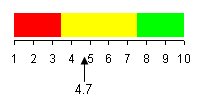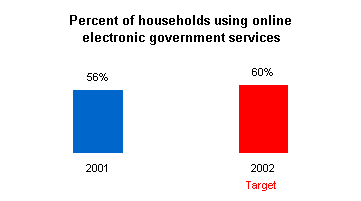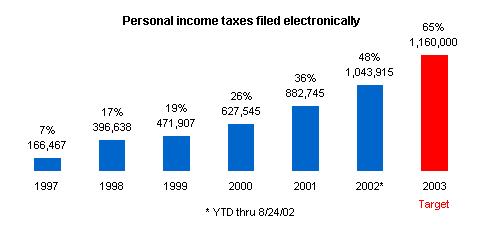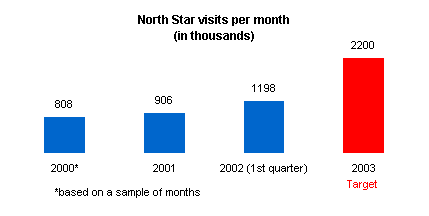
|
Electronic Government Services Initiative Electronic commerce over the Internet is a centerpiece of the global information revolution. Because citizens are going online at an ever-increasing rate, electronic commerce is at once global, national and local in both scope and impact. Sound policy is essential for both the Internet and online commerce to reach their full potential. This requires a partnership among all the individuals and groups that have an interest in the creation of technology policy within the State, and does not lend itself to the traditional "top-down" model that provides solutions dictated by government to industry. The legal framework supporting commercial transactions on the Internet should be governed by consistent principles across state, national and international boundaries. This will lead to predictable results regardless of the jurisdiction in which a particular buyer or seller resides. Government will be doing purchasing, inventory, and sales from a central file server. Electronic tax filing, and payroll communications, also will be conducted online. Such initiatives will increase government efficiency, provide for a comprehensive and coordinated information management system, and create avenues for citizen communication and participation with their government.
The Big Accounting Initiative Score Online vehicle license renewal transactions. Personal taxes filed electronically. Number of agencies on Secure Financial Transactions (SFT) server. Number of government services that can be transacted online. |
|||||||||||||||||||

|
|||||||||||||||||||
|
|
|||||||||||||||||||
Note: Data gathered regarding the year 2001 was obtained from a survey performed by the Management Analysis Divisions (MAD). The Office of Technology contracted with MAD to survey the public about Electronic Government Service (EGS) usage, as well as their use of the Internet, and how they would like to use the Internet for government services. MAD focused more heavily on the rural communities than did the U of M, because the state is interested in determining what types of services are available to the outstate parts of Minnesota. It is already known that the metro area has access to these services. MAD will be conducting another survey for year 2002 and will include representation of rural and metro EGS usage. |
|||||||||||||||||||
| top
|
|||||||||||||||||||
|
|
|
||||||||||||||||||
Note: Online Vehicle Tab Renewal was the first EGS transaction offered by the State of Minnesota. Increased acceptance of this online transaction has helped shape future EGS initiatives. From 1997 to 2001, online renewals have increased 55 percent. |
|||||||||||||||||||
| top
|
|||||||||||||||||||
|
|
|||||||||||||||||||
Note: This indicator reflects electronic filing by individual filers. It is also a measure of the general interest in conducting government business online vs. other avenues (mail, phone). Electronic tax filing is usually one of the first electronic transactions a citizen will conduct with the State of Minnesota. Eight times more people filed electronically in 2000 than in 1997. |
|||||||||||||||||||
| top
|
|||||||||||||||||||
|
|
|||||||||||||||||||
Note: The North Star online system encompasses approximately eighty state web sites, including the State of Minnesota's portal (www.state.mn.us). A hit is defined as each file requested by a visitor. North Star is the State of Minnesota's internet portal. Traffic volume on North Star and sites hosted by North Star are an indication of trends throughout the state. As citizens become more comfortable connecting with the State electronically, they will access more services that way. |
|||||||||||||||||||
| top
|
|||||||||||||||||||
Number of agencies on Secure Financial Transactions (SFT) server. |
|||||||||||||||||||
|
|
|
||||||||||||||||||
Note: In order to do online financial transactions with citizens, an agency must have developed an application that connects to the state's approved payment engine (currently EZ Gov's Secure Financial Transaction, or SFT). As agencies expand their SFT capacity they will be able to offer more online transactions. As of 2000, only the Department of Public Safety and the Department of Revenue had an SFT. By February 2002, the Department of Public Safety and the Chiropractic Boards were using SFT's, and the Department of Natural Resources and the Secretary of State were in the testing stages. The Board of Nursing Department of Transportation, and Department of Children Families and Learning are expecting to offer online transaction in the near future. |
|||||||||||||||||||
| top
|
|||||||||||||||||||
Number of government services that can be transacted online. |
|||||||||||||||||||
|
|
|
||||||||||||||||||
Note: There are currently approximately 1,600 services provided by the State of Minnesota across the agencies. The Office of Technology is in the process of defining which of those services are most valued by the citizens of the state. Once those services are determined through a statewide survey, the office can begin to work directly with the related department/ agency's to bring those services to the public. The Office of Technology expects to bring on at least four additional services in 2002. |
|||||||||||||||||||
| top
|
|||||||||||||||||||






